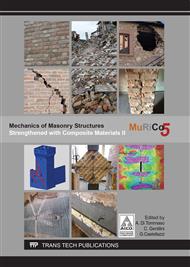p.274
p.282
p.289
p.298
p.305
p.313
p.319
p.326
p.334
Bond Behavior of FRCM Carbon Yarns Embedded in a Cementitious Matrix: Experimental and Numerical Results
Abstract:
The use of inorganic cement based composite systems, known as Fiber Reinforced Cementitious Matrix (FRCM), is a very promising technique for retrofitting and strengthening the existing masonry or concrete structures. The effectiveness of FRCM systems is strongly related to the interface bond between inorganic matrix and fabric reinforcement, and, since the major weakness is often located on this interface, the study of stress-transfer mechanisms between fibers and matrix becomes of fundamental importance.FRCM are usually reinforced with uni-directional or bi-directional fabrics consisting of multifilament yarns made of carbon, glass, basalt or PBO fibers, disposed along two orthogonal directions. The difficulty of the mortar to penetrate within the filaments that constitute the fabric yarns and the consequent non-homogeneous stress distribution through the yarn cross section makes difficult to access the characterization of the composite material. The use of polymer coatings on the fibers surface showed to enhance the bond strength of the interface between fibers and mortar and, as a consequence, to improve the mechanical performance of the composite. The coating does not allow the mortar to penetrate within the filaments while is able to improve the bond between the two materials and to increase the shear stress transfer capacity at the interface.An experimental session of several pull out tests on carbon yarns embedded in a cementitious matrix was carried out. Different embedded lengths have been analyzed, equal to 20, 30 and 50 mm. The carbon yarns object of this study were pre-impregnated with a flexible epoxy resin enhanced with a thin layer of quartz sand applied on the surface.A variational model was proposed to evaluate the pull-out behaviour and failure mechanisms of the system and to compare numerical results to the experimental outcomes. Evolution of fracture in the yarn-matrix system is determined by solving an incremental energy minimization problem, acting on an energy functional which account for brittle failure of matrix and yarn, and for debonding at the yarn-matrix interface. The model was able to accurately describe the three phases of the pull-out mechanism, depending on the embedded length.
Info:
Periodical:
Pages:
305-312
Citation:
Online since:
July 2017
Price:
Сopyright:
© 2017 Trans Tech Publications Ltd. All Rights Reserved
Share:
Citation:


